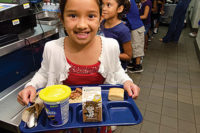Preparing kids to have 21st century critical-thinking and problem-solving skills may seem like an unlikely task for dairy producers and processors, but in California the dairy industry is doing just that with nutrition education programs that align with Common Core State Standards.
First introduced by the Council of Chief State School Officers and the National Governors Association in 2010, Common Core standards are designed to equip kids with skills to succeed in college, career and later life. More specifically, the standards are designed to prepare students with what they need to know in mathematics, English language arts and literacy, and outline skill sets to be achieved at the end of each grade level.
By aligning our nutrition education programs with the Common Core standards, Dairy Council of California is supporting teachers, empowering students and building healthy eating habits and a lifelong value for milk and dairy foods. The free, school-based nutrition education programs are used in 75% of California school classrooms. With a focus on elevating the health of children and parents, these programs have been our backbone since the organization was founded nearly 100 years ago.
While our commitment to nutrition education never waivers, the educational environment is changing, and so too our programs must evolve to maintain relevancy and expand reach. As an industry, we need to continually be looking for opportunities to engage with children, parents and families about the important benefits of milk and dairy foods. Providing schools with instructional resources that support the needs of teachers and engage students is one way to do just that.
A common skill set
Some specific areas addressed in the Common Core standards include evidence-based writing, reading and speaking; building knowledge around real-world subjects through information-based and nonfiction content; and using academic vocabulary. Nutrition education is a natural fit with these standards, as making healthy food choices is a real-world issue that children and adults face daily. In addition, the skills needed to independently make healthy food choices are the same skills emphasized in Common Core.
With emphasis now on evidence-based, informational and argument writing, our lesson plans provide multiple cross-curricular, information-based opportunities for students to practice these skills while learning about how and why to eat healthy foods from all five food groups. Programs are available for grades K–12, with each one building off the prior year, providing a staircase of complexity and building knowledge around nutrition. Additionally, teachers can download digital, grade-specific reading and writing activities that support Common Core standards.
Nutrition education in the classroom is complemented through various other touch points that allow us to reach more kids, more times and in more ways. These connections effectively help young people develop healthy eating habits early on or change unhealthy eating patterns. The touch points are:
- The Mobile Dairy Classroom is an interactive learning lab that brings a real cow and calf to California schools. It shows how milk and dairy foods get from the farm to the school cafeteria and family table. An interactive website and video extends learning opportunities.
- The Smarter Lunchrooms Movement uses strategic placement of foods in the cafeteria to nudge children to make healthier choices like choosing milk and dairy foods. Through the movement, kids are able to practice what they learn in the classroom.
- Parent-specific programming through the PTA reinforces what kids are learning through school programs.
- School-based health care centers — increasingly important in the changing health care environment — provide yet another setting for nutrition education.
Advocating for nutrition education
Schools are experiencing transformative change and face mounting pressures to increase student achievement while managing costs. Nutrition education — if we are not careful — could slip through the cracks. Dairy Council of California is making every effort to align nutrition programs with the classroom demands placed on teachers.
At the same time, we’re seeing huge changes in our health care system that can’t be ignored. Doctors’ offices and hospitals are increasingly focused on acute needs and emergency care, while basic care has shifted to community-based health care sites in schools, churches, community clinics and drug and grocery stores. There is also a move toward disease prevention and wellness versus treatment of medical issues after they arise. All of these changes make school-based nutrition education even more critical.
While the dairy industry’s presence in schools is often thought of in terms of milk products sold in the cafeteria, the opportunities are much greater with nutrition education programs that align with school needs and the industry’s commitment to improving the health of children and their parents.




